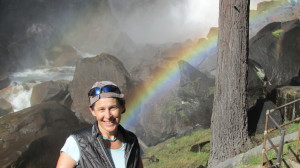Nature, John Muir, and the National Parks
Fresno Bee, October 2, 2015
- Yosemite and Sequoia national parks are sources of natural beauty
- John Muir’s philosophy rooted in transcendentalism
- We all can benefit from making contact with nature
This year marks the 125th anniversary of Sequoia and Yosemite national parks. There are practical reasons for preserving natural areas. Pure water and clean air are obviously useful. Biodiversity and flourishing natural ecosystems serve human interests.
But behind these parks is a philosophical ideal that celebrates the aesthetic and spiritual value of nature. Natural wonders sing to our souls. Yosemite Valley is a marvel. Sierra summits inspire. And the big trees awaken reverence.
Consider this: As the Rough fire raged this summer, firefighters took extra precautions to save sequoia trees. These ancient organisms have a kind of value which should be cherished and protected.
We are not born understanding this. Nature love is a late development. Sequoias were once logged. And a dam destroyed Hetch Hetchy Valley. Practical interests sometimes prevail. But beauty matters as much as business.
One source for this moral and aesthetic ideal is the American philosophical movement known as transcendentalism. The transcendentalists celebrated the spiritual power and wild delight of nature. They worshiped natural beauty, eating clouds and drinking wind, as Ralph Waldo Emerson once put it.
Emerson felt a sense of homecoming and companionship in the presence of nature. He argued that nature was “medicinal,” curing us of the stress of our workaday lives. Emerson disciple Henry David Thoreau dreamed of making direct contact with the mysterious power of nature. Thoreau set off on walking tours in search of contact – one of the original American backcountry hikers.
Emerson and Thoreau inspired John Muir, who brought transcendentalism to Central California. Muir’s enthusiastic nature worship helped create the national parks and the Sierra Club. Emerson himself visited Yosemite in 1871, accompanying Muir to the Mariposa grove of giant sequoias.
Muir said that going to the woods was going home. He described the big trees of the Sierra as superior beings arrived from another star – calm, bright and godlike creatures that leave us awestruck. He described Yosemite Valley as a work of art and a natural temple.
In defense of the national park idea, Muir explained, “Mountain parks and reservations are useful not only as fountains of timber and irrigating rivers, but as fountains of life.”
Muir recognized the practical importance of the mountain ecosystem for the well-being of the rivers and waters of our own Central Valley. But he also thought that mountain grandeur and primeval forests were a source of spiritual power.
Granite cliffs, towering trees and sparkling waterfalls somehow elevate the spirit. They put human concerns in proper perspective. The sequoias have stood silently while entire civilizations have come and gone. The mountains have been carved by forces more powerful than anything homo sapiens could ever devise.
For some, this is alien, intimidating and incomprehensible. Some get vertigo in high places. The natural world is not all wildflowers and rainbows. There are fires and storms and earthquakes as well. But these infernal powers remind us of our fragility and the need to savor beauty when we find it.
Muir worried that people saw forests as weeds to be cleared or timber to be profited from. Today we have a different problem. We often cannot see the forest for the trees – or the trees themselves. We are no longer in contact with the natural world. Much of the time, we are immersed in virtual reality. We would often rather play with our phones and poke our computers than make contact with the world. And we miss out on the good medicine of nature, which offers a cure for the stresses of the human world.
National parks allow us to explore beauty and commune with nature. We should celebrate the inspired and tenacious work of visionaries such as Muir. We should also thank the nameless firefighters and trail-builders whose sweat and blood allows us to enjoy these places in safety.
These parks have a long history – and deep philosophical roots. But 125 years is only a small fraction of the life of a sequoia. It is nothing in comparison with the tempo of glaciers. Let’s hope that these parks last another 125 years so that our great-great-grandchildren may continue to make contact with these awesome fountains of life.


